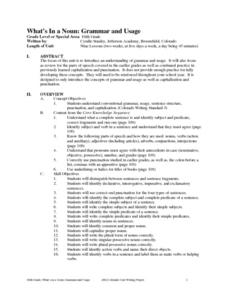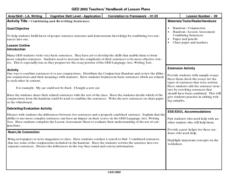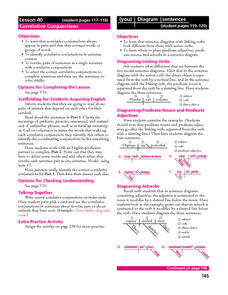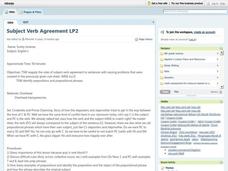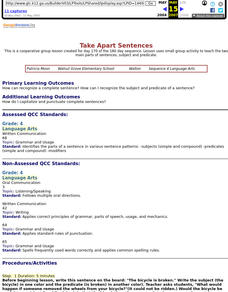Curated OER
Lesson: A Garden Party of My Own
Kids look at a beautiful work of art to practice grammar, make connections from life to art, and sketching. They identify all the parts of grammar they see in the image, discuss what they see and do on a picnic, and then draw an imaged...
Curated OER
What's In a Noun: Grammar and Usage
Nine lessons in a grammar and usage unit provide endless opportunities for drill and practice. Topics include the four types of sentences, subject and predicates, nouns, verbs, adjectives, pronouns, adverbs and prepositions, conjunctions...
Curated OER
Indirect Object Pronouns
Directly address the use of the indirect object pronouns with a lesson plan on how to locate them in sentences and worksheets that provide opportunities for practice using them.
Curated OER
Combining and Rewriting Sentences
Learners practice combining sentences using the conjunction handout provided. They search magazines and newspapers to identify combined sentences that use conjunctions. Finally, these are rewritten again as two separate sentences.
Curated OER
Correlative Conjunctions
Students identify correlative conjunctions in sentences and then rewrite pairs of sentences as a single sentence with correlative conjunctions. They practice diagramming sentences of various sentence patterns and then write a personal...
Curated OER
Negative Imperatives and Idioms
Students identify and use positive and negative imperatives and idioms in written and spoken dialogues, and use irregular verbs in written and spoken sentences. They complete various worksheets, re-write dialogues, and complete an...
Curated OER
Understanding Nouns
Students identify types of nouns. In this grammar lesson, students define what a noun is and identify the various types of nouns in sentences. This grammar lesson is geared towards Special Education students.
Curated OER
Attractive Adjectives
Third graders, in a foreign language class, identify and use adjectives in sentences.
Curated OER
Acting Out Verbs
Learners act out verbs. In this verbs lesson, students identify and highlight the action words in a poem. As a class, the learners act out the verbs, reinforcing the idea that verbs are action words.
Curated OER
Past Tense Verbs
Students read Hilburt The Halibut, and discuss the verbs in the story. Using the overhead projector, and a copy of the story on a transparency, the class examine the verbs and identify all the past tense verbs within the story.
Curated OER
Adjectives in Poetry
Students read selected poems from the book Beast Feast, by Douglas Florian. They identify at least two to three keyword facts about each beast highlighted in the poems.
Curated OER
What's Happening?
Students participate in a grammar game. They identify verbs, adverbs and phrases. They complete a quiz at the end of the lesson to determine how much practice they still need.
Curated OER
Verbs and Adverbs
Young scholars identify the verbs, nouns and pronouns in a groups of sentences . As a class, they discuss the importance of verbs and discover the function of adverbs. To end the lesson plan, they examine the difference between...
Curated OER
Subject Verb Agreement
Seventh graders engage in a lesson plan that investigates the concept of identifying prepositions and their coinciding phrases. They also develop the skill of connecting the right form of a verb with its subject. Then students take a...
Curated OER
Some Homophones Are Verbs
Fifth graders participate in a spelling bee. For this verbs and homophones lesson, 5th graders review how most verbs are formed in the past tense and how this differs from irregular verbs. Students identify homophones and homographs and...
Curated OER
Adjectives and Descriptive Phrases
Students examine the use of adjectives and descriptive phrases to improve their written pieces. In this adjectives and descriptive phrases lesson, students look at demonstrative adjectives, common adjectives, and proper adjectives. They...
Curated OER
Writing From the Heart
Young scholars improve their writing skills by identifying people, places, ideas, and things that are important to them. In this writing skills lesson, students discuss things that are important to them. Young scholars use the heart map...
Curated OER
Pronoun Party
Pupils collect pronouns to replace nouns in sentences together and on paper. Students review nouns with each other. Pupils identify the pronouns in a variety of sentences provided by the teacher. The Pronoun Party continues.
Curated OER
Gathering and Evaluating Sources for the "Greatest American" Speech
Young scholars brainstorm a list of criteria for determining credible sources for their research. They research information to include in their "Greatest American" speech. Students will evaluate all sources by applying the criteria they...
Curated OER
The Physics of Cell Phones
Students explain how cell phones work. In this physics lesson, students describe the advantages and advantages of having one. They identify the different parts of a cell phone.
Curated OER
Take Apart Sentences
Fourth graders explore the two main parts of sentences, subject and predicate. They, in groups, mix up their sentence strips and then place them face down and have a contest to see which group can rebuild the sentences correctly in the...
Curated OER
Eye No the Write Won!
Second graders practice with synonyms, antonyms, and homophones. After listening to a Berenstain Bears story, 2nd graders utilize worksheets imbedded in this plan to gain practice identifying these parts of speech. A nice lesson!
Curated OER
Nouns and Verbs and Proper Nouns, Oh My!
Second graders identify nouns and verbs in written communication. They distinguish between between nouns, proper nouns, and verbs. Students discuss the difference between these parts of speech. In partners, 2nd graders write a sentences...
Curated OER
Subject/Verb (Compound) Recognition Practice
In this compound subject and verb practice worksheet, students read an informative lesson. Students then respond to 10 questions that require them to identify gerunds and identify compound subjects and compound verbs.

